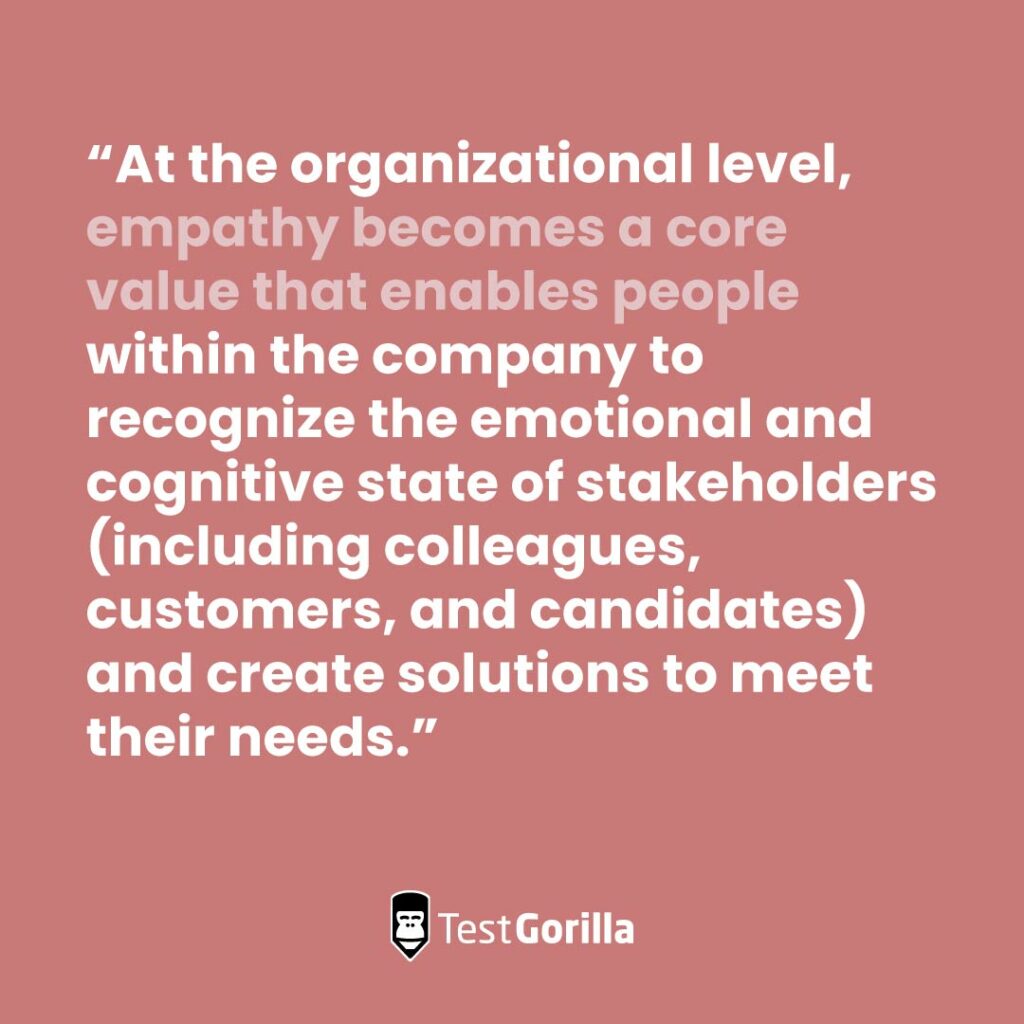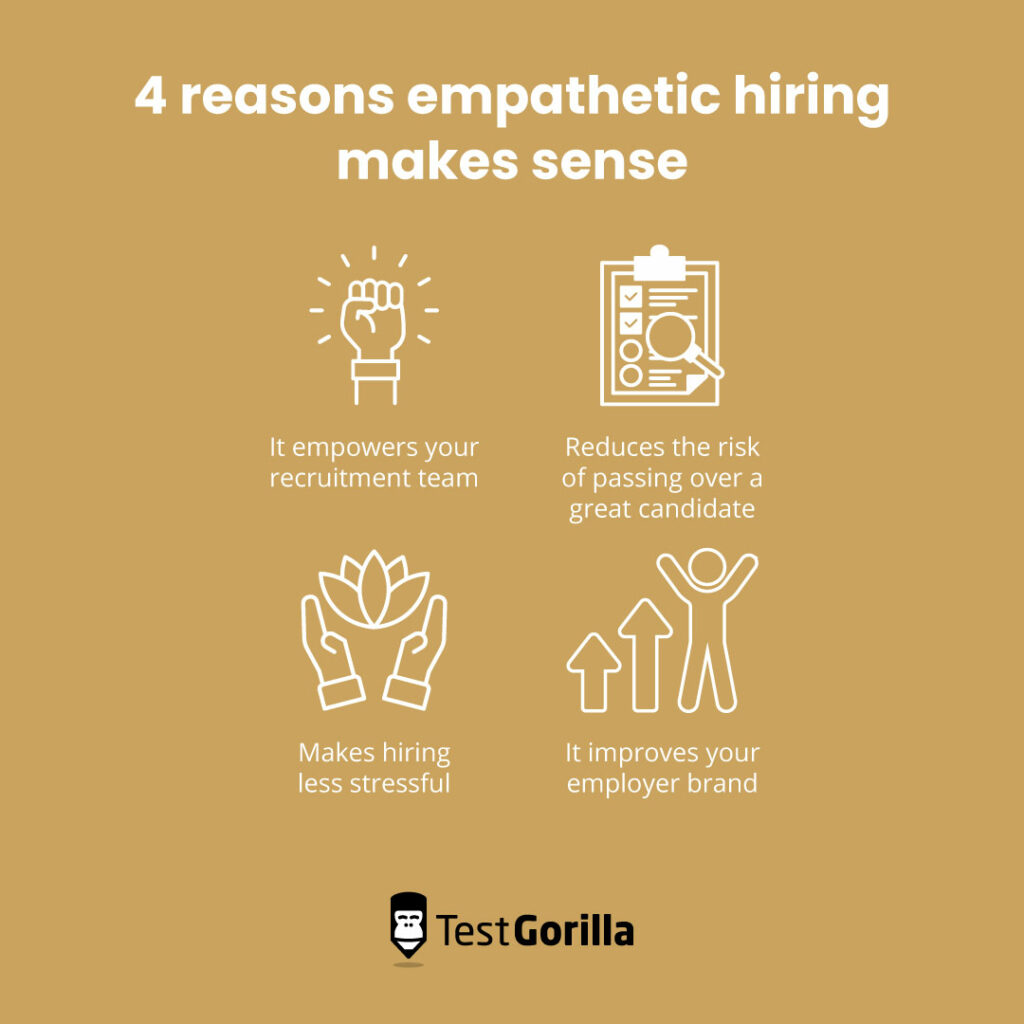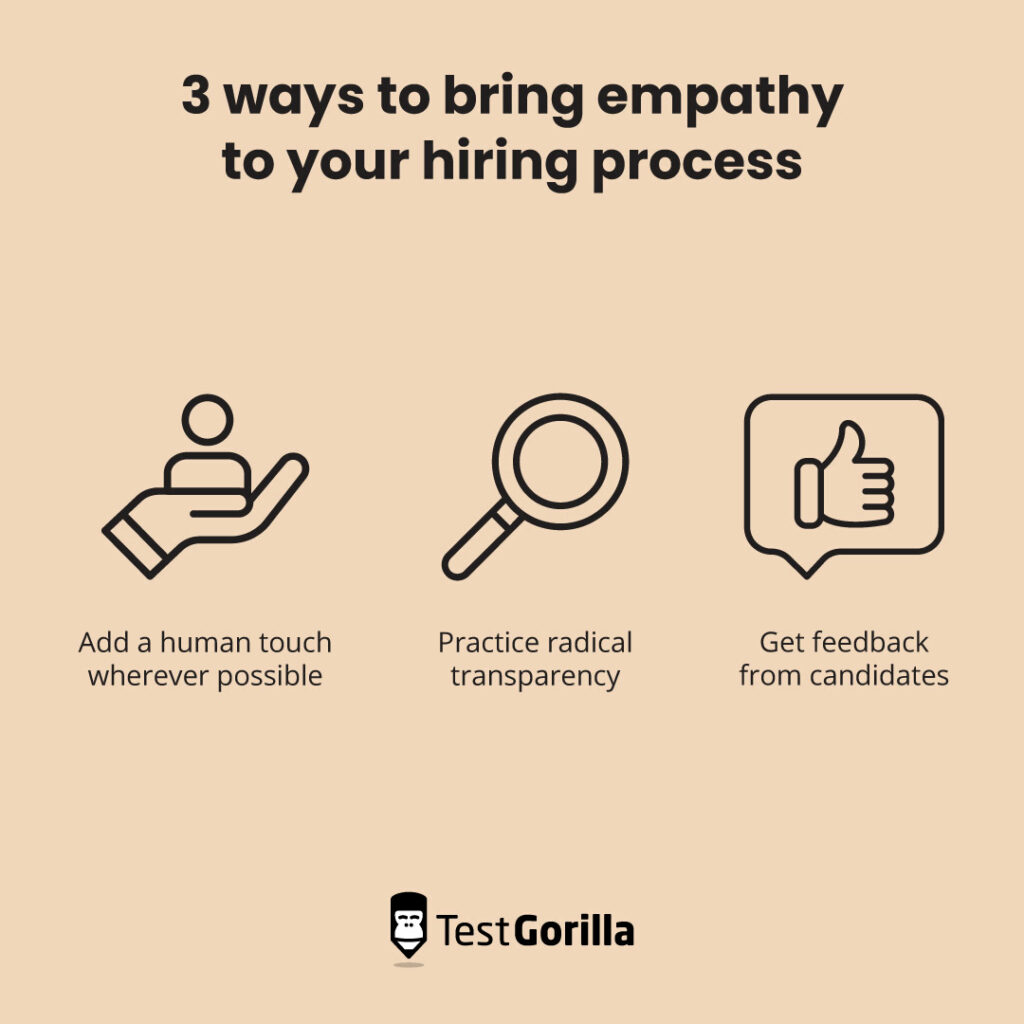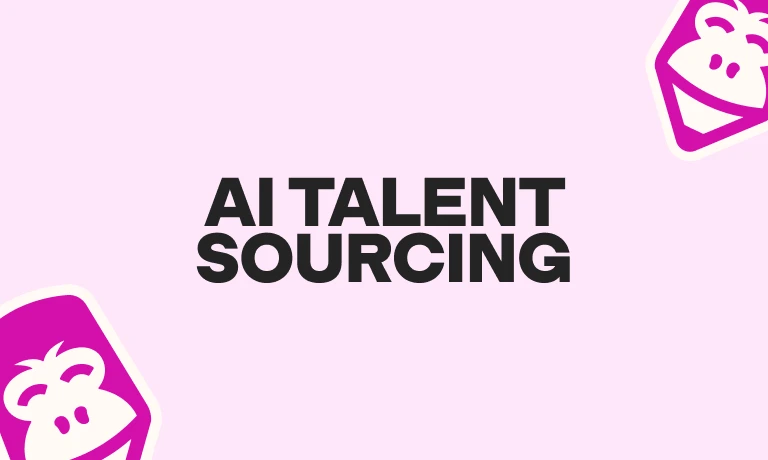Applying for a job is an inherently vulnerable experience.
Candidates spend hours trawling through job boards and LinkedIn posts, searching for opportunities that align with their skillset and passion. They edit and re-edit their resumes and cover letters to convince prospective employers they are the right fit for the job.
Then comes the waiting game. As days, weeks, and sometimes even months pass in anticipation of a response.
Of course, all too often, that reply never comes. Or, it arrives in the form of a boilerplate email informing the candidate that they’re not the right fit for the position.
Demoralized, the hopeful applicant goes back to the drawing board, never having got the chance to demonstrate their value or understand why they were rejected in the first place.
Even the lucky few who manage to get through this trial by fire still have to face up to a gauntlet of interviews that could stop their progress at any step.
This approach sends a clear message to every candidate in the recruitment funnel.
It tells them that:
The employer doesn’t value their time and effort.
The company expects a lot from people in return for very little.
Transparency and respect are not prioritized during the hiring process.
In a job market where company culture is priority number one for many job seekers, this messaging is unlikely to net you a great candidate who is motivated to work for your company.
Instead, why not try a little empathy?
What is empathetic hiring?
At an individual level, empathy is simply the ability to notice and understand other people’s emotions from their point of view.
At the organizational level, empathy becomes a core value that enables people within the company to recognize the emotional and cognitive state of stakeholders (including colleagues, customers, and candidates) and create solutions to meet their needs. Research from the Center for Creative Leadership shows that managers who demonstrate this skill also deliver improved job performance.
By adopting empathy across the hiring process, companies can show applicants they know the stress of applying for a job and are working to reduce them through a more transparent, human, and compassionate candidate experience.
4 reasons empathetic hiring makes sense
1. It empowers your recruitment team
Performance-driven management has become a key focus for HR teams in recent years, with metrics like cost-of-hire and speed-to-hire reigning supreme.
However, neither of these measuring sticks compare to quality-of-hire. After all, effective recruitment has a proven long-lasting impact on business profitability, while the cost of a bad hire can be up to 30% of an employee’s annual salary.
Recruiters and hiring managers who prioritize efficiency above all else are far more likely to play it safe and find the least risky candidate –one who ticks the most boxes but doesn’t bring any game-changing potential to your company.
But, if you train your team to lead with empathy, then the equation changes significantly.
Let’s say you have to choose between two applicants for a job.
Applicant number one is passionate, motivated, and willing to pick up new skills across their career but falls short of some of the requirements for the role.
Applicant number two has the industry experience and a relevant degree but doesn’t seem excited by the role and shows no particular interest in your company.
In an empathetic hiring process, recruiters and hiring managers can look past proxies such as experience and qualification and take the time to understand each candidate’s qualities and how they align with your organization’s values. So, the first candidate becomes just as viable as the second.
2. It reduces the likelihood you’ll pass over a great candidate
The traditional hiring process is anything but objective. At every step of the recruitment funnel, a host of irrelevant factors can disqualify a candidate from contention.
Names have a significant impact on hiring decisions. Applicants with “popular” names are likelier to progress, while those with difficult-to-pronounce or less “white-sounding” names are filtered out. More surprisingly, just adding a middle initial to the name on your resume can make hiring managers think you’re more educated, professional, and intelligent.
Candidates who have worked at less well-known companies or studied at less prestigious institutions are often passed over in favor of those with more illustrious resumes.
Candidates who display traditional markers of self-confidence and sociability perform better during the interview stage. Unfortunately, this means that introverted or neurodiverse individuals who struggle with certain aspects of social interaction (such as maintaining eye contact) are filtered out at this stage.
During virtual interviews, negative perceptions about the candidate’s environment or lack of comfort with technology (due to technical difficulties or connectivity issues) can work against otherwise qualified applicants.
When you hire with empathy, there is a greater emphasis on putting yourself in the candidate’s shoes. So, indicators that would otherwise be judged harshly by hiring managers are examined in view of the applicant’s circumstances and competencies, which gives them a much better shot at getting hired.
A great example of putting talent over individual traits can be seen at digital communications giant Cisco. When expecting mother Alena Dalin was interviewed for a job at the company, she was conflicted about revealing her pregnancy to the hiring manager, fearing that she would lose out on the opportunity.
When she came clean, the interviewer was completely unphased by the admission and worked out a plan to accommodate Alena’s status without affecting her ability to join the company. Alena got the job and now leads the company’s digital marketing effort.
It makes hiring less stressful for candidates and hiring managers
One of the biggest roadblocks to empathetic hiring is the perceived power imbalance between employers and candidates. In truth, this gap has closed significantly in recent years, with the labor market heating up and persistent talent shortages appearing in multiple industries such as healthcare, manufacturing, and oil & gas.
Unfortunately, many companies have failed to account for this new normal and continue to put candidates through a rigid and often unforgiving hiring process characterized by:
Multiple in-person interviews staggered over the course of weeks.
Significant delays between each phase due to verification steps, i.e. (reference checks)
Minimal time for Q&A and receiving candidate feedback.
Hard deadlines on interview timings and delivery of work samples.
An empathetic employer recognizes that candidates might struggle with many aspects of this process. For example, they may struggle to carve out time to show up for an interview during a busy workday or require immediate answers to a few queries before they can commit fully to you as an employer.
By acknowledging these difficulties and making room for a more flexible approach that factors in the candidates’ needs, you can keep more great talent engaged until the end of the hiring process.
4. It improves your employer brand
Empathy is a vital differentiating factor in a job market where workers are still reeling from the aftereffects of the pandemic and ensuing social upheavals. In a recent study on the State of Workplace Empathy, 90% of Gen Z employees said they would be more willing to continue working with an empathetic employer.
The data shows that any company that wants to engage and retain top-tier talent needs to demonstrate its commitment to building processes around candidates. A great experience can not only convince an in-demand jobseeker to choose your company, but it also helps populate your recruitment pipeline with other great applicants who are genuinely motivated to work for you.
According to certain estimates, a great employer brand can help drop your cost-to-hire by up to 43%. On the flip side, a company with a bad reputation can spend up to 10% more on its hiring.
Referrals are also a key aspect to consider here. Even candidates who aren’t hired can become your greatest cheerleaders if you treat them with kindness and respect.
At Providence Health & Services, a renewed focus on candidate experience helped the company improve on many key hiring metrics.
An added benefit was that many hopefuls began posting on social media expressing gratitude for the company’s willingness to answer questions and relay feedback through each step of the hiring process. Buoyed by their experience, certain candidates even applied for positions at the company multiple times after initial rejections until they were eventually hired.
The best insights on HR and recruitment, delivered to your inbox.
Biweekly updates. No spam. Unsubscribe any time.
3 ways to bring empathy to your hiring process
1. Add a human touch wherever possible
It’s tempting to rely on automated tools to filter through the mass of resumes you receive for open job postings, but these tools must be deployed carefully.
If your system is set up to identify suitable candidates based on your existing recruitment database, you may introduce unconscious bias into a supposedly objective system.
Similarly, a keyword-based ATS might disqualify otherwise great candidates simply because they didn’t enter the correct term in their application.
Another thing to consider with these solutions is how much time they can add to the application process.
Sure, you might be saving on your time-to-hire, but candidates must pay for those savings with effort when they’re forced to copy their resumes into tedious application forms. This unnecessary work can cause even the most motivated candidate to disengage from your hiring process.
Finally, when it comes to following up, do away with automated emails. Instead, try to reach out personally, regardless of whether you’re congratulating a successful applicant for moving on to the next step of the hiring process, rejecting an unsuccessful candidate, or simply confirming the submission of a resume.
Although time constraints might stop you from penning a heartfelt message to every one of these individuals, a couple of lines written by a relevant hiring manager can go a long way for candidates.
Make sure to send out these communications as soon as you have an update on your side so that hopeful applicants aren’t left in the dark for too long.
2. Practice radical transparency
A key source of anxiety for candidates is the lack of information they receive across the hiring process. These asymmetries include ambiguous job descriptions that don’t communicate the full scope of an open position, a lack of information on salary and benefits, and a lack of clarity around the length and number of interviews before a job offer is finally made.
It’s difficult to see how employers benefit from this complexity. Indeed, they could benefit significantly by setting candidates up for success.
An easy starting point is the job description. Include the specific responsibilities of the role, how work will be evaluated, and the criteria for success. Also, make sure to add relevant details about salary range and benefits. This will help candidates decide whether they’re suitable for the role.
Of course, applicants will likely still have more specific questions about the job. To help answer these, consider providing more detailed resources to address their concerns.
Justine Jordan, the head of marketing at software company Widbit, took this idea and ran with it.
After posting about a new position for marketing manager at the company on LinkedIn, Justine started collecting questions about the job from interested parties across her social media accounts. She then used these queries to build a “living FAQ” for the position that addressed as many points as possible.
Justine supplemented this FAQ with a detailed hiring flowchart describing how the hiring process would progress, including pass/fail conditions for each step.
Reflecting on the experiment, Justine said that the effort enabled her to have much deeper conversations with the people that passed through to the interview stage. Ultimately it allowed her to hire a high-potential candidate who would otherwise have been passed over due to a lack of experience.
3. Get feedback from candidates
Although social media is a great place to interact with job seekers, you might consider setting up a more formal channel to gather feedback on your hiring process. Considering that 75% of candidates say they’ve never been given their chance to offer an opinion to employers, just this simple act could set you apart from the competition.
eSignature giant DocuSign offers a candidate experience survey sent out to anyone who enters their recruitment funnel regardless of success. It allows candidates to provide their input on issues such as the response time of recruiters during the hiring process and the likelihood of referring the company to their colleagues.
Of course, communication is a two-way street, and applicants are likely to find just as much value in the opinion of hiring managers and recruiters. If you can, take time out to let candidates know how they performed across the process.
For those that have moved on to the next stage in the recruitment funnel, this information can help boost their chances of landing the job. Anyone who didn’t make it through can use this feedback to improve their chances of securing the next opportunity that pops up at your organization.
Use skills-based hiring to get a complete picture of your candidates
Work experience and qualifications may tell you something about a candidate’s history, but relying on these criteria to guide your hiring decisions won’t get you any closer to finding talent that can perform on the job.
For that, you must take stock of the full range of capabilities the applicant offers.
Let’s say you’re hiring a PR & Communications specialist, a role that requires competency in several areas, including market research, verbal reasoning, and social media management. You can try to infer whether a candidate possesses these abilities based on the positions they’ve worked in previously or their degree, but the only way to know if they can deliver is by assessing their skills.
Using this approach, you can formulate customized assessments that test every skill required for the job. In the process, you’ll see candidates that would otherwise fail to stand out due to less-than-stellar resumes prove their abilities and rise to the top of your applicant pool.
If empathetic hiring is about truly understanding the person sitting across the table from you, then there’s no better way to do this than through skills-based assessments.
To find out more about how multi-measure talent assessments help companies revolutionize the way they hire, check out how the travel management service TruTip used TestGorilla to save money and radically improve their candidate experience.
Related posts
You've scrolled this far
Why not try TestGorilla for free, and see what happens when you put skills first.

















